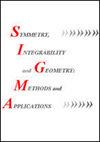The Higher-Rank Askey-Wilson Algebra and Its Braid Group Automorphisms
IF 1
3区 物理与天体物理
Q2 MATHEMATICS
Symmetry Integrability and Geometry-Methods and Applications
Pub Date : 2023-10-18
DOI:10.3842/sigma.2023.077
引用次数: 0
Abstract
We propose a definition by generators and relations of the rank $n-2$ Askey-Wilson algebra $\mathfrak{aw}(n)$ for any integer $n$, generalising the known presentation for the usual case $n=3$. The generators are indexed by connected subsets of $\{1,\dots,n\}$ and the simple and rather small set of defining relations is directly inspired from the known case of $n=3$. Our first main result is to prove the existence of automorphisms of $\mathfrak{aw}(n)$ satisfying the relations of the braid group on $n+1$ strands. We also show the existence of coproduct maps relating the algebras for different values of $n$. An immediate consequence of our approach is that the Askey-Wilson algebra defined here surjects onto the algebra generated by the intermediate Casimir elements in the $n$-fold tensor product of the quantum group ${\rm U}_q(\mathfrak{sl}_2)$ or, equivalently, onto the Kauffman bracket skein algebra of the $(n+1)$-punctured sphere. We also obtain a family of central elements of the Askey-Wilson algebras which are shown, as a direct by-product of our construction, to be sent to $0$ in the realisation in the $n$-fold tensor product of ${\rm U}_q(\mathfrak{sl}_2)$, thereby producing a large number of relations for the algebra generated by the intermediate Casimir elements.高阶Askey-Wilson代数及其辫群自同构
对于任意整数$n$,我们提出了秩$n-2$ Askey-Wilson代数$\mathfrak{aw}(n)$的一个定义,推广了通常情况$n=3$的已知表示。生成器由$\{1,\dots,n\}$的连通子集索引,简单而相当小的定义关系集直接来自于已知的$n=3$的情况。我们的第一个主要结果是证明了$\mathfrak{aw}(n)$的自同构的存在性,满足$n+1$链上编织群的关系。我们还证明了不同n值下代数的余积映射的存在性。我们的方法的一个直接结果是,这里定义的Askey-Wilson代数被投射到由量子群${\rm U}_q(\mathfrak{sl}_2)$ n -fold张量积$n -fold张量积中的中间卡西米尔元素所产生的代数上,或者等价地,投射到$(n+1)$-穿球的Kauffman括号串代数上。我们还得到了Askey-Wilson代数的一组中心元素,作为我们构造的直接副产品,它们在${\rm U}_q(\mathfrak{sl}_2)$的$n$次张量积的实现中被送至$0$,从而产生了由中间卡西米尔元素生成的代数的大量关系。
本文章由计算机程序翻译,如有差异,请以英文原文为准。
求助全文
约1分钟内获得全文
求助全文
来源期刊
CiteScore
1.80
自引率
0.00%
发文量
87
审稿时长
4-8 weeks
期刊介绍:
Scope
Geometrical methods in mathematical physics
Lie theory and differential equations
Classical and quantum integrable systems
Algebraic methods in dynamical systems and chaos
Exactly and quasi-exactly solvable models
Lie groups and algebras, representation theory
Orthogonal polynomials and special functions
Integrable probability and stochastic processes
Quantum algebras, quantum groups and their representations
Symplectic, Poisson and noncommutative geometry
Algebraic geometry and its applications
Quantum field theories and string/gauge theories
Statistical physics and condensed matter physics
Quantum gravity and cosmology.

 求助内容:
求助内容: 应助结果提醒方式:
应助结果提醒方式:


